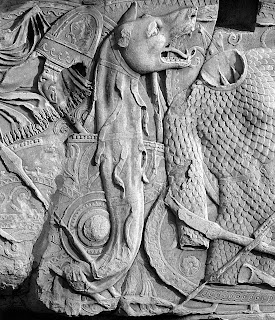The following is a partial repost of an earlier article. As I've now settled on Uther Pendragon as a manifestation of the ruler of the Daco-Britons centered at Banna/Birdoswald on Hadrian's Wall, it seemed appropriate to offer this again within that context.
If there is any truth to the comet story, we may be talking about the comet of 442 A.D. This “star” appeared at and entered into Ursa Major, the Great Bear. This may be significant, as the name Arthur was associated with the Welsh word for bear, and Geoffrey of Monmouth tells us that part of the dragon-star actually signified Arthur.
From Cometography: 1800-1899, by Gary W. Kronk:
In concluding, I really have only one question to ask - and it is an unanswerable one, unfortunately. While Uther's dragon-head standard is certainly a reflection of the Roman period draco, as the draco came into the Roman army through people such as the Dacians, Thracians and Sarmatians (all present in Britain as troops) might it have symbolically represented a cometary deity or monster belonging to the indigenous religion of these peoples?
I find this in the Wikipedia article on the Dacian draco (https://en.wikipedia.org/wiki/Dacian_Draco):
The body of the standard, depicting a dragon-like balaur or a large snake, was seen by the Dacians as a manifestation of the sky demon or "heavenly dragon".[21][22] This relates to their supreme god Zalmoxis who was a sky god (cf. also Tomaschek[23]).[24] In the Hallstatt Period "proper", the decorative pattern of a dragon head or a serpent became quite common in Dacia. The dragon symbol is also represented on the silver Dacian bracelets of the Classical period.[25] The snake-shaped bracelets and other similar ornaments show not only the spread of the snake as a decorative motif but also its significance in Dacian material civilization.[26][27]
NOTE: The sources cited for this information appear to be quite old and I am not, therefore, convinced of their reliability. I would urge those who wish to learn more about the mythological applications of the draco to embark upon their own research.
I find this in the Wikipedia article on the Dacian draco (https://en.wikipedia.org/wiki/Dacian_Draco):
The body of the standard, depicting a dragon-like balaur or a large snake, was seen by the Dacians as a manifestation of the sky demon or "heavenly dragon".[21][22] This relates to their supreme god Zalmoxis who was a sky god (cf. also Tomaschek[23]).[24] In the Hallstatt Period "proper", the decorative pattern of a dragon head or a serpent became quite common in Dacia. The dragon symbol is also represented on the silver Dacian bracelets of the Classical period.[25] The snake-shaped bracelets and other similar ornaments show not only the spread of the snake as a decorative motif but also its significance in Dacian material civilization.[26][27]
NOTE: The sources cited for this information appear to be quite old and I am not, therefore, convinced of their reliability. I would urge those who wish to learn more about the mythological applications of the draco to embark upon their own research.





No comments:
Post a Comment
Note: Only a member of this blog may post a comment.